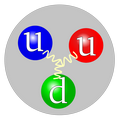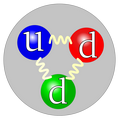|
Ensemble Organization
Contents Select the section that interests you. |
|
Introduction

Consistent with many of the themes that are discussed throughout this web resource, it is striking that The Entire Universe has unfolded and organized itself conforming to nothing other than its own Natural Laws - natural laws that have been in place from The Beginning.
The Universe's Liberty to behave, self-organize, and evolve naturally has been Conserved throughout time.
While much of our comprehension of the way the Universe has unfolded improves due to advancements in the physical (e.g. chemical, electrical, magnetic, nuclear, quantum) sciences, there are significant holes in our understanding as they pertain to the successive stages of organization of both living and non-living systems.
Elsewhere within this resource, considerable effort is applied to providing a framework within which the mechanics of the genesis of human behavior and personality may be worked out. In this chapter we will provide a broader contextual framework within which that effort exists.
ConserveLiberty has adopted specific nomenclature to describe various "traits" that are observed to occur throughout nature. These terms are used to describe the behaviors of atoms, for example. The same terminology can be used to describe behaviors and traits observed in "living" systems, instinctual behaviors, societies, etc. While we may reserve the use of some of the jargon primarily for animal instincts and behaviors, other of the terminologies will be used across the board.
ConserveLiberty's most basic concepts: Fundamental Prerequisites derive from the Fundamental Resonance. It is not possible to define the Fundamental Resonance using words or pictures. At times, ConserveLiberty generically refers to the Fundamental Resonance as The Big Math with the understanding that The Big Math will never be understood fully by finite cognitive assets. At other times ConserveLiberty inadequately expresses the Fundamental Resonance as Change Happens ... Always. No matter how completely we come to understand the simplicity of the Fundamental Resonance, change happens ... always.
All that exists manifests all of the Fundamental Prerequisites. Without any one of them, Existence itself does not happen. Examples are:All the Fundamental Prerequisites manifest together as an ensemble and ALL are required for existence ... always.
- Variation (no two things are ever exactly the same)
- Randomness (how the difference between two related things comes to be)
- Lineage ... one, then the other, then the other ...
Because this chapter focuses on the way All of Creation has unfolded, it is important to note the terminology used by the particle physicists that have studied and tried to make rational and credible sense of the creation of the Universe as well.
Physicists considering the reality underlying All That Is start with these concepts: The particle physics perspective is a bit more complicated. At The Beginning the four Fundamental Interactions were unified, and then quickly separated. Quickly after that the Elementary Particles "condensed" from the cooling universe in relationship with one or more of the Fundamental Interactions. Quickly after that various ensembles formed manifesting as all matter within the entire universe within the first ten seconds after the Big Bang.
Just like the Fundamental Interactions and the Elementary Particles, the Fundamental Prerequisites are not composed of anything other than themselves. In the end, they all originate from the same thing. Consider them as multiple sides of the same coin. When looked at from different perspectives, the "same thing" can appear differently. In the end, there is only ONE TRUTH, yet MANY PERSPECTIVES.
ConserveLiberty refers to All That Is at the initial moment of the Big Bang as the Creation Initiate. From that, all four of the Fundamental Interactions and the Elementary Particles condensed out as the universe unfolded. Simliarly, at The Beginning was the Fundamental Resonance, and the Fundamental Prerequisites unfold from that.
The Fundamental Prerequisites give rise to the Fundamental Rules. Eventually the Fundamental Rules give rise to the Personality Filters, Ensembles, and Tapestries. Similarly, the Elementary Particles and Fundamental Interactions give rise to the baryons, then neutral atoms (with leptons), then molecules, eventually giving rise to the Personality Filters, Ensembles and Tapestries.
ConserveLiberty and the particle physics community are both looking at the same thing. Reality - "that which drives or governs the behavior (e.g. observable or measurable activities) of Creation".
One of the Fundamental Prerequisites, is the principle of Interaction - two different things will always be in Relationship. This gives rise to the "Ensemble".
The Ensemble Principle, simply stated, suggests that each increased "layer" or "unit" of complexity within the universe is composed of an ensemble of "units" from layers of reduced complexity below it. A simpler interpretation of the Ensemble Principle is that all things are made up of other things.
The Ensemble Principle is a Rule derived from the Interaction Prerequisite. It holds true until we get to "The Two Initial Things", the Creation Initiate (see below) which presumably existed at the moment of the Big Bang. Prior to that there were None.
The Big Picture
With the possible exception of Level 0, all higher complexity organizational levels (and the units within them) are an ensemble of the reduced complexity organizational levels beneath them.
As ensembles ascend in complexity, they branch into differing Branch Types.
The Branch Types:
A - Interactivity or Reactivity
B - Compartmentalization or Separation
C - Persistent Information Storage
D - Living Unit
E - Function or Behavior
The initial Branch Type, A, indicates an "Interactivity" or "Reactivity" organization.
Example: "Level 0-A" indicates - Complexity Level 0 - of Branch Type A.
Level 0-A - The "Creation Initiate":
"Quantum physics thus reveals a basic oneness of the universe." - Erwin Schrödinger, 1887 - 1961
The Creation Initiate existed at the moment of the putative Big Bang. It is from which all other organization levels and types derive.
According to Big Bang theory, at the exact Beginning a "singularity" existed - either/both "infinitely everything" or "nothing". Immediately after the Big Bang ... everything existed. All of Creation existed within a space having infinitesimally small dimensions.
Alternatively, if the dimensions were larger, the Universe was so dense that you likely had a black hole containing the entire ... Universe.
In any case, just prior to and just after the Big Bang, an "outside observer" looking directly at the place the Creation Initiate was formed would have seen something like the depiction nearby.
(Note the "literary device" used. Suspend disbelief in order to "get" the concept.)
At the moment of the Big Bang, many assume that from "Nothing" → "One" was created. All unified as One even if only for a moment. The Theory of Everything.
ConserveLiberty suggests a different hypothesis, similar to the first, and simply modified.The Suggestion → From Nothing → Two were created! ← ImportantSince all three hypotheses are abstractly equivalent, for simplicity ConserveLiberty will assume the hypothesis: from Nothing → Two ! However, when considering Reality, abstract cognitive thought is recommended and embraced by ConserveLiberty.
An Alternate → From All That Was Before → Two were created! ← Note
Abstractly → From All That Was Before → More ! ← Note
How/Why two?Assume the law of conservation of mass/energy is true. A net total of Something cannot be derived/created from a net total of Nothing.How Fast are we Going?
Assume Nothing has a value of 0 and that Something has a value of 1. Clearly, 0 = 1 is not mathematically true.
What if two Somethings (Sa and Sb) are created and the values of Sa = 1 AND Sb = -1? Then in this case, 0 = (+1) + (-1), and that IS mathematically true.
Using the jargon of particle physicists, the "two" are "matter" and "antimatter".
When matter and antimatter collide they annihilate each other. Current theory suggests this is predominantly what happened just after the Big Bang. Most of the matter/antimatter created was annihilated. It is believed that only 1/30,000,000 or less of the Creation Initiate was not annihilated.
ConserveLiberty suggests that while Baryon asymmetry may explain why some of the expected antimatter is "nowhere to be found" ... another explanation is that it may not be found because it is not findable.
One simple hypothesis is that is it too far away. Quite a bit of the antimatter that we cannot find may be farther away than is observable to us.
Consider, for example, the inflation epoch and conservation of momentum.
Assume (for simplicity) that before the Big Bang, total Momentum (M) = 0. Then, the Big Bang occurred. Sa and Sb, both existing in equivalent magnitudes in terms of the mass/energy composing them, move away from each other in directions that conserve the total momentum existing before the Big Bang.
If Ma = 1 and Mb= -1, then M (before) = Ma + Mb (after). 0 = (+1) + (-1). Momentum is conserved.
Everything moved apart during the inflation epoch at much, much faster than the speed of light. Much is either not detectable ever ... or not detectable yet. Including much matter/antimatter, not findable by the other.
Given the very high densities, portions of matter and antimatter would have collided, resulting in annihilation. Due to the speeds achieved during the inflation epoch, with both matter and antimatter separating faster than the speed of light, what didn't collide survived ... some never to detect or encounter each other again. Ever.
The Cognitively Advanced Matter Life Forms can't find the Antimatter. The Cognitively Advanced Antimatter Life Forms can't find the Matter.
Two sides of the same coin, unable to validate that The Other even exists. Anywhere.
The Ultimate Dimorphism of All That Is !!!
That is a natural question that folks "who want to know" want to know about.
Who knows? Relative to what? Without knowing "which marker post" (reference frame) is actually stationary, how can one tell?
ConserveLiberty will leave you with something to think about.
Consider The Conservation of Momentum. For the sake of argument, assume that the "place" where the Big Bang happened had a velocity of zero at the Initial Moment (before any time elapsed.) With Velocity = 0, of course Momentum = 0.
The Big Bang happens, and from Nothing → Two. (Let's stick with two for simplicity.) The Two move apart (quickly!) Assume Total Momentum is conserved. Thus, The Two are moving in different directions.
Gravity attracts All That Is to All That Is. Astronomers measure the various galaxies moving to and away from each other, calculate their apparent masses, velocities, etc.
What is "interpreted / perceived" is the Shapely Supercluster, which we are attracted to, the Dipole Repeller, which we appear repelled from, and the Cosmic Microwave Background (first produced 377,000 years after the Big Bang).
From the calculated the CMB rest frame (the frame of reference in which there is no motion through the CMB) one can derive that the earth appears to be moving at 368 ±2 km/s relative to the reference frame of the CMB.
So now you know.
Again, It's All Unavoidably Relative !!!
Keeping that introduction in mind, lets go back to The Beginning.
Level 0-A - The "Creation Initiate":
See above.
Level(s) 0-A - n - 1-A:
From the Creation Initiate are derived all the Fundamental Interactions and Elementary Particles. From the Fundamental Resonance are derived the Fundamental Prerequisites. To simplify, there are n additional organizational stages in between Level 0 and 1.
Much that is summarized below (and more) can be gotten to by examining Wikipedia's chronology of the universe.
At the initial moment when the Creation Initiate came to be (at absolute maximum density) matter and energy were equivalent. All were unified, including the four fundamental interactions.
After the initial Planck epoch (0 to 10-43 seconds), gravity and the electronuclear force had separated.
Earlier (above), it was suggested that the Ultimate Dimorphism was the simultaneous creation of matter and antimatter, thereby conserving the Law of Conservation of Mass/Energy. While something (Sa = not(0)) cannot be created from nothing (S = 0), Sa (matter) and Sb (antimatter) can be created simultaneously from (S = 0) so long as Sa + Sb = 0.
This is consistent with the Fundamental Prerequisite of Interactive Dimorphism.
However, the only way that Sa and Sb ever manifests Persistance (a higher order Fundamental Rule which all that does persist must have!) is if they DO NOT interact with each other. Interaction of Sa with Sb results in annihilation. The Two become None.
It is possible, and even likely, that quite a bit of Sa and Sb did interact, and thus annihilate. However, a very, very small amount of Sa and Sb might not, and probably did not, interact with each other.
So now, focusing just on the Sa, we have matter that also has the Fundamental Prerequisite of Interactive Dimorphism. And yet for this very infinitessimally brief moment, It, all by itself, is One. Meaning ... NOT Two. Thus, the Sa that is not interacting (and annihilating with) Sb itself becomes "Two". In this case, from All That Is that is fully unified, Gravity and the Electronuclear Force separate.
The manifestation of Fundamental Prerequisite of Interactive Dimorphism is "restored."
Since Interactive Dimorphism is a Fundamental Prerequisite, it was not ever violated. Rather, simultaneous with the separation of matter and antimatter created at the moment of the Big Bang, and the random circumstance resulting in the separation of some Matter from Antimatter (and vice versa) ... Gravity then separated from the Electronuclear Force, consistent with continuous Interactive Dimorphism.
Language is cannot precisely describe what may have occurred near the Singularity moment when All That Is arose from Nothing.
After the grand unification epoch (10-43 to 10-36 seconds), the electronuclear force had separated into the strong force and the electroweak force. The strong force holds most ordinary matter together because it confines quarks into hadron particles, such as the proton and the neutron. The strong force also binds neutrons and protons to create atomic nuclei.
The separation of the strong force from the electroweak force (a phase transition) enabled the creation of matter and antimatter. That initiated an expansion of the universe at a rate much faster than the speed of light.
The inflationary epoch occurred during the first part of the electroweak epoch. During the inflationary epoch (10-36 to 10-32 seconds) the universe is believed to have increased linearly at least 10+26 fold. That is equivalent to expanding from 1 nanometer (10-9 m) to 10.6 light years (100 trillion kilometers) in less than 10-32 seconds.→ Universe expansion was trucking so fast you would have missed it. ←By the end of the electroweak epoch (10-36 to 10-12 seconds) the electroweak force had separated into the weak force and the electromagnetic force.
After 10-12 seconds the 4 fundamental interactions (gravity, strong, weak, electromagnetic) are separated. The universe is 10.6 light years in diameter and exists as a quark-gluon plasma still too hot (dense) for quarks to combine to form hadrons (i.e. mesons or baryons.) Thus begins the quark epoch.
The Ensembles Unfolding
Level 1a-A - "Elementary Subatomic Particles" - The Quarks:
Quarks and gauge bosons are elementary particles. Neither are further divisible into subcomponents. Quarks can assemble in ensemble with the strong interaction as hadrons. Guage bosons are the force carriers that carry the fundamental interactions of nature. Gluons are gauge bosons that carry the strong interaction.
The quark epoch (10-12 to 10-6 seconds) ended once the average energy of particle interactions fell below the binding energy of hadrons.
Summarizing the elementary particles:
- Fermions:
- 12 Quarks (experience all 4 fundamental interactions)
- 6 types (flavors) - Up, Down, Charm, Strange, Top, and Bottom
- For every flavor, there is a corresponding antiparticle.
- 12 Leptons (do not experience the strong interaction)
- 6 types (flavours)
- 3 generations
- Charged - electron, muon, tau
- Neutral - electron neutrino, muon neutrino, tau neutrino
- For every flavor, there is a corresponding antiparticle.
- Bosons
- Gauge bosons (force carriers)
- Gluons - carry the strong interaction
- W+, W-, and Z bosons - carry the weak interaction
- photons - carry the electromagnetic interaction
- "Gravitons" - carry the gravity interaction (theoretical boson, not ever found (yet)).
- Scalar bosons
- The Higgs Boson
Summarizing the Hadrons:
- Baryons (made up of three quarks)
- Mesons (made up of one quark and one antiquark )
- Pions
- Exotic hadrons (made up of more than three valence quarks)
Level 2-A - "Composite Subatomic Particles - the Hadrons":
The hadron epoch (10-6 to 1 second) began at 10-6 seconds (hadrons are forming.) Hadrons come as baryons and mesons. Protons and neutrons are examples of baryons. Initially, hadron/anti-hadron pairs could form and exist in thermal equilibrium. The temperature of the universe continued to fall (expansion). Most of the hadrons and anti-hadrons were eliminated in annihilation reactions by the end of the hadron epoch (1 second after the Big Bang).
The general physics community observes that a small residue of hadrons remained, can find no evidence of the anti-hadrons, and has attempted to explain the observations (and lack thereof) via various theories, such as CP-symmetry violation or interactions out of thermal equilibrium (i.e. rapid expansion decreasing the occurrence of pair-annihilation).
ConserveLiberty believes that it is likely that the rapid expansion of the universe moved sufficient amounts of the remaining quarks and antiquarks apart that they did not have opportunity to annihilate each other. Any that did, did. The remaining 1/30,000,000 of the total did not.
We are now at the end of the 1st second since the Big Bang, and at the end of the hadron epoch.
Hadrons:
- Baryons
- Protons (composed of two Up and one Down Quarks, held together by gluons).
Because up quarks have a charge of +2/3 e, and down quarks have a charge of -1/3 e, a proton has a net charge of (+2/3) + (+2/3) + (-1/3) = +1.
- Neutrons (composed of one Up and two Down Quarks, held together by gluons).
A neutron has a net charge of (+2/3) + (-1/3) + (-1/3) = +0.
- Mesons
- These come in a variety of types, and are composed of one of the six Quark types and one of the six anti-Quark types, held together by gluons. Generally, mesons are transitory products of high energy interactions.
Level 1b-A - "Elementary Particles" - The Leptons:
The lepton epoch began 1 second after the Big Bang, after most of the hadron / anti-hadron annihilation ended. The universe was still hot enough to create lepton/anti-lepton pairs, and they were in thermal equilibrium. Approximately 10 seconds after the Big Bang the temperature of the universe had fallen to the point where lepton/anti-lepton pairs were no longer created, and lepton / anti-lepton annihilation occurred, leaving a small residue of leptons.
Examples of leptons are electrons and neutrinos. They do not undergo the strong nuclear interactions, and are not composed of quarks.
After the first 10 seconds from the moment of The Big Bang, and the annihilation of many of the hadrons, anti-hadrons, leptons, and antileptons ... the universe was then dominated by photons. Thus began the photon epoch.
Note: Had enough of the atomic- and sub-atomic particles yet?
Click here → for a summary list of them.
Level 3-A - "The Nuclei":
During the first few minutes of the photon epoch (minutes 3-17 after the Big Bang), atomic nuclei were formed during the process called Big Bang nucleosynthesis. At the end of 17 minutes, the universe cooled sufficiently that all Big Bang nucleosynthesis stopped. At this point, all the nuclei (protons and neutrons) that would ever be formed were formed, and have remained so to this day. The initial distribution of nuclei after Big Bang nucleosynthesis is believed to be 75% hydrogen, 24% helium, traces of lithium and deuterium, perhaps very tiny amounts of beryllium and tritium. The universe still has a similar composition today.
An atomic nucleus - One or more protons (with zero or more neutrons) bound together as an atomic nuclei. We find numerous types of these, each with distinct nuclear properties such as decay characteristics, etc.
In the nearby illustrations, blue balls are neutrons, red balls are protons. They are held together by the residual strong force that binds the quarks together that make neutrons and protons. The actual structural arrangement is conjectured, and cannot be determined. At right shows the formation of a deuterium nucleus via the collisions of two protons.
Level 4-A - "The Atom - a simple chemical":
From 17 minutes through 378,000 years after the Big Bang, the universe cooled (expanded) sufficiently to allow nuclei (hadrons) to combine with electrons (leptons), thereby forming electrically neutral atoms. Photons no longer interacted predominantly with matter (expansion led to sufficient dilution) such that the universe became transparent.
(Note: The other atomic nuclei were formed much later as a result of stellar nucleosynthesis, supernova nucleosynthesis, neutron star mergers, and cosmic ray spallation.)
The period of time when the formation of neutral hydrogen was energetically favored is refered to as the recombination epoch, and occurred about 378,000 years after the Big Bang. These neutral hydrogen atoms generally formed with the electrons in a high energy state, and the electrons quickly transitioned to their low energy state by emitting photons. This "decoupling" of photons from the hydrogen atoms as they transitioned to their low energy state, now free to travel through the universe without being impeded by matter resulted in the cosmic microwave background radiation. After the recombination epoch, the fraction of free electrons and protons as compared to neutral hydrogen decreased to a few parts per 10,000.
Nuclei with electrons. We find numerous types of these, and each is distinguishable by chemical properties.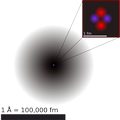
Note that each Atom is composed of a Level 3 Nucleus (which is itself composed of Level 2 Baryons (which are themselves composed of Level 1 Quarks)) and Level 1 Electrons.
Level 5-B - "Formation of stars, galaxies, galaxy clusters, and larger structures":
Since the recombination epoch (378,000 years after the Big Bang) structure formation has been underway to this very day.
Level 5-A - "The Molecule - a compound chemical":
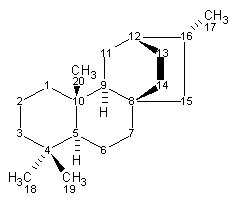 Collections atoms, bound together by various electrostatic forces distinguished as chemical bonds having different characteristics and mechanisms.
Collections atoms, bound together by various electrostatic forces distinguished as chemical bonds having different characteristics and mechanisms.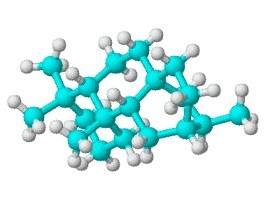
These two different images are of the same molecule, atisane. At left is a three dimensional representation, at right a two dimensional representation.
Level 6-A - "Chemical Mixtures (solutions, suspensions, or colloids,) Associations, and Reactions":
 Various chemical transformations are enabled by virtue of the molecules present, their physical and chemical properties, etc.
Various chemical transformations are enabled by virtue of the molecules present, their physical and chemical properties, etc.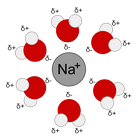
At left is a homogeneous mixture of water molecules.
At right is an illustration of a sodium atom dissolved in water.
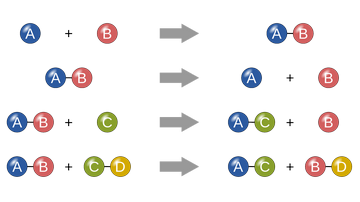
Chemical reactions result in the transformation of one or more chemicals (either atoms or molecules) into different chemicals.
Level 6-A - n - 7-A - [zero, one, or more reserved levels of organization between 6 and 7]:
Speculative.
Note:
Up until this point, all increasing levels of organizational complexity have been of the interactivity or reactivity branch type (Type A). However, as we increase complexity above this level, one can view organization using broader or more abstract concepts such as "compartmentalization", "information", etc.
The Branch Types:
A - Interactivity or Reactivity
B - Compartmentalization or Separation
C - Persistent Information Storage
D - Living Unit
E - Function or Behavior
From here on, we may subdivide the organizational levels into branch types. Different branches may have the same level of complex organization, but they achieve different conceptual purposes.
Branch types do not necessarily remain separated from other branch types as we move up organizational levels. They may re-merge, or further branch yet again.
Level 7-A (Level 7, Branch Type A) - "Simple Enzymes":
A single molecule, usually large (a macromolecule), whose chemical action is made possible by the juxtaposition of different parts of the macromolecule having different chemical properties together, such that a new chemical reaction may be catalyzed due to the nearby synergies.
In the example at left, the enzyme galactosidase catalyzes the breakdown of maltose into glucose. Within the enzyme, depicted in ribbon notation, the maltose substrate (in black) is held within the active site by the amino acid residues indicated in red.
Level 7-B (Level 7, Branch Type B) - "Compartmentalization":
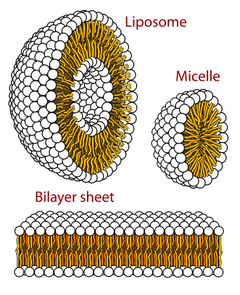


Boundary persistence due to various physical and chemical characteristics. For example, differences in melting points (or boiling points), densities, solubility indexes, etc., can cause persistent separation of chemical entities. Thus, liquid water may pool together within an oily environment, or oils within an aqueous environment, or atmospheres above a solid or liquid environment, etc.
Note: Level 7 - n - 8 - [zero, one, or more reserved levels of organization between 7 and 8]:
Speculative.
Within these levels, branching can occur to various states having parallel higher orders of organization. For example, one branch may lead to star and planet formation. Another branch leads to Life, or to be more accurate, the phenomena of persistent Lineage.
Within each of the branch types, there are also additional levels, each subsequent level representing a successively higher level of organization as an ensemble of various of the components below. There are also differing branches, although they may interact or be dependent upon one another synergistically. Thus, for example, we see the branches after "Functional Macromolecular Assembly" to "Gene" and "Cell" at Level 9.
Continuing with the Persistent Lineage related Life branches:
Level 8 - "Functional Macromolecular Assembly":
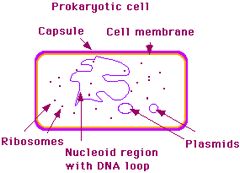

It is at this level that we see specialized macromolecular associations such as lipid bilayers creating cell walls, multi-subunit enzymes and multi-protein complexes, location dependant function, and the symbiotic macromolecular machinery responsible for genetic persistence and variability of function.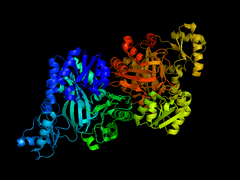
Level 9-C (Level 9, Branch Type C) - "The Functional Gene":
Specific evolution by selection of genes (information implied by and encoded within one or more specialized macromolecular structures) that improve and enhance the persistence of the Functional Macromolecular Assemblies.
While a common view of "gene" consists of simply the sequence of nucleic acid residues in a polyribonucleic acid strand (or double strand), our notion of "The Functional Gene" is a more functionally oriented one. The gene does not have an information role apart from the biological machinery used to interpret it, no more than a string of bit states stored on a memory drive has any function or meaning at all apart from the machinery used to read and "interpret" it. Thus, "The Functional Gene" as used here at Level 9 is the result of an interaction between Level 8 macromolecular assemblies of nucleic acid strands into Level 8 genes, working in ensemble fashion with Level 8 macromolecular assemblies of amino acid and or nucleic acid residues (and their modifications) into Level 8 enzymes. Both these interacting together hold the key to how gene sequences are interpreted, and so we consider this a higher level (Level 9) ensemble organization creating a Functional Gene.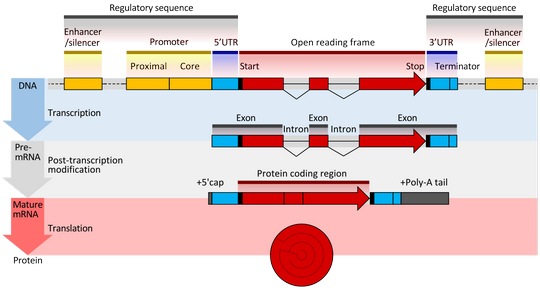
As with all the progressions from one level to the next, there is somewhat of a "chicken or egg" synergy between 8 and 9. Level 8 cannot exist persistently without Level 9 contribution. Level 9 cannot exist at all without Level 8 foundation.
Level 9-D (Level 9, Branch Type D) - "The Functional Cell":
One may consider the Functional Cell a consequence of ensemble "cooperation" leveraging Level 7, Branch B Compartmentalization with the advantages of Level 8 Functional Macromolecular Assembly.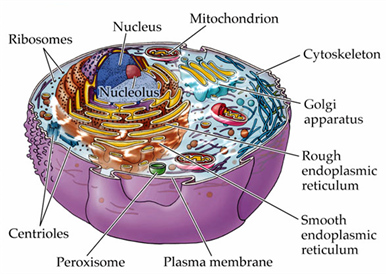
As indicated earlier, the various branches of the various different organization levels can and do interact with each other, and so we have here contributions from other Level 9, 10, and 11 branches as well.
Level 10-C - "The Multi-gene":
A collection of functional genes responsible for the production of one multi-subunit enzyme or functional macromolecular assembly.
While it may seem that rather than Level 9, this level of organization may belong to Level 8, in fact the same "chicken and egg" consideration exists as does for Level 9.
Level 10-D - "The Multi-Cell":
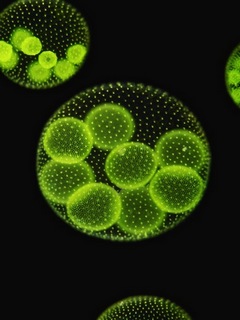
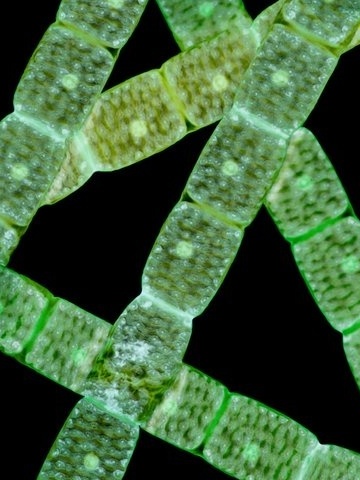
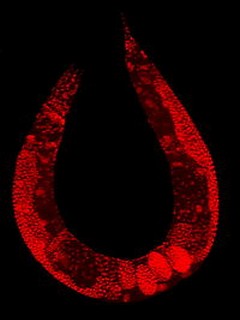
Cells which persist grouped together. While this may simply be a collection of cells that all perform and behave similarly, it may also, and most importantly, refer to collections of cells that may perform or behave differently. This level of cooperation of an ensemble of cells, some behaving and contributing differently than others, critically increases and advances the options of what are possible at this higher level of organization.
Level 11-E - "Phenotype":
Note that this is Branch Type E - Function or Behavior.
Phenotype is typically considered simply the observed impact of the consequence of the existence and action of a particular gene or genes. However, Phenotype is considered higher order than Multi-gene or Multi-Cell since it is dependent on environment, other genes, as well as variations in its own gene sequence (structural and/or regulatory), etc., for observation of its specific end-result characteristics and/or behaviors.
Level 11-D - "The Organism":
Multi-Cells which persist organized together. Same consideration as above. Again, while the number of different cell types or multi-cell types could equal One, this level of organization often refers to collections of different multi-cell types, cooperating together as one Organism.
Note:
Since branches can work synergistically with one another, they can re-coalesce at later, higher stages of organization, in this case continuing with the development of organism traits and behaviors.
At this point, lets arbitrarily continue with the perception and behavior oriented Life branch type:
Level 12-E - "The Filter":
A behavioral or perception "Filter" is considered to be the result of a collection of one or more interacting phenotypes that results in the presence (or lack of) perceptive abilities or behavioral instincts or preferences.
Other than in the simplest of cases, we would not think of the "Filters" as themselves "Traits" (see below) unless one Filter was sufficient to generate a particular Trait.
An example in the perceptive world would be "the ability to see the color 'red.'" While one gene may appear to impact the presence of our "Red Filter", the fact is that many interacting genes and biological structures are required for the filter to properly operate.
Another example from the automobile world would be the Trait "Speed." Speed is actually dependent on a number of underlying components (we consider them here as "Filters") that come together to create the trait or ability for "Speed." One "Filter" for this might be the size of the fuel lines to the engine. Another "Filter" might be the fuel used. Each of these Filters are themselves the result of an ensemble of components. For example, the spark plugs (another "Filter") are themselves made of various separate components, and are not at all functional without an energy source.
When trying to understand the behavioral and perceptive traits of various living individuals, it is important to consider that these are made up of one or more "Filters" and that each of the Filters are made up of one or more phenotypes, which themselves are made up of one or more functional genes in association with functional cells, and so on.
Level 13-E - "The Trait":
A perceptive or behavioral trait is a collection of one or (usually) more Filters working as an ensemble to generate a particular aspect of interpreting and/or responding to the external world.
In addition, a Trait can also be an Ensemble Trait. Similar to Multi-gene or Multi-cell, this represents one or more Traits interacting with each other in order to give rise to a new (similar or dissimilar) Trait.
Just as in the example of the "Speed" trait for vehicles, there will often be more than one manner in which a Trait or Ensemble Trait can be built from the multitude of components (e.g. Traits, Filters, Phenotypes) available.
Thus, while there certainly is a natural biological foundation underlying perception, behavior, and personality in general, it will be very difficult to work out the mechanism of actions that define these using traditional statistical and analytical methodologies.
Level 13-D - "The Social Unit":
The Social Unit (a collection of one or more organisms, bound together "locally" from a communication perspective) is included here simply because many creatures, and humans in particular, are socially cooperative creatures. Thus, interactions with the Social Unit, and the larger Culture it finds itself within, also plays a role in the generation of perceptive and behavioral trait phenotypy.
Level 14-E - "The Behavior":
(Big B) Behavior is what we refer to as the result of all the traits, filters, and external influences, acting in ensemble fashion to generate an individual response.
Level 15-DE - "The Culture":
The summed outcome of the behaviors within a collection of one or more Social Units bound together by a broad common denominator. While one common denominator can be "Location", it is important to realize that groups of social units within a common geographic area can and do separate themselves so that they are not so tightly bound to each other. In this case, more than one Culture can be present within a broad geographic location.
What do each of these transitions from one level or organization to the next have in common?
They are generated via an Ensemble of interactions from the lower (or foundational) levels.
A Helpful Resource Section
- The Guide to the Universe
- Subatomic Particles
- Wikipedia on Subatomic Particles
- Wikipedia on anti-particles
- Wikipedia on Standard Model
- Wikipedia on the Big Bang
- Wikipedia on Biochemistry
- Wikipedia on the Atom
Summary
We'll wrap it up here in a later revision.
Last Update: 22 Sep 2018 13:55 PDT

